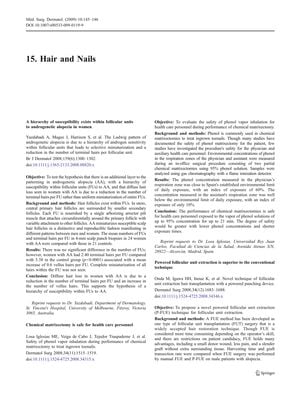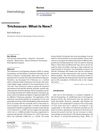Hair And Nails: Studies On Hair Loss, Chemical Matrixectomy, And Hair Transplantation Techniques
March 2009
in “
Medical & surgical dermatology
”
androgenetic alopecia terminal hairs follicular unit vellus hairs scalp biopsies chemical matrixectomy phenol powered follicular unit extraction P-FUE hair transplantation heparanase hair follicle homeostasis ephrin-A3 hair follicle density anagen development Notch/RBP-J signaling melanoblasts postnatal hair follicles AA FU

TLDR Women with androgenetic alopecia have fewer terminal hairs, phenol in nail surgery is safe, and a new hair transplant method is faster and less damaging.
The document presents several studies related to hair and nails. One study found that diffuse hair loss in women with androgenetic alopecia (AA) is due to a reduction in the number of terminal hairs per follicular unit (FU) and an increase in vellus hairs, supporting the hypothesis of a hierarchy of susceptibility within FUs to AA. This was concluded from a comparison of the mean numbers of FUs and terminal hairs per FU in scalp biopsies from 24 women with AA and 21 controls, where women with AA had significantly fewer terminal hairs per FU. Another study concluded that chemical matrixectomy using phenol is safe for healthcare personnel, with phenol concentrations during the procedure staying within or below Spain's environmental limits of daily exposure. A third study proposed a novel powered follicular unit extraction (P-FUE) technique for hair transplantation, which was found to be superior to the conventional technique, with a shorter harvesting time and lower graft transection rate. Other studies discussed include the role of heparanase in hair follicle homeostasis, the pathogenic mechanisms of onychomatricoma with dorsal pterygium, the effect of ephrin-A3 on hair follicle density and anagen development in neonatal mice, and the importance of Notch/RBP-J signaling in the proper location and timed differentiation of melanoblasts in postnatal hair follicles.







